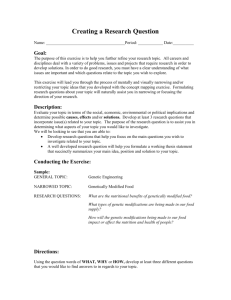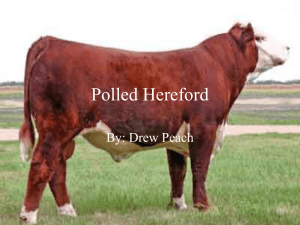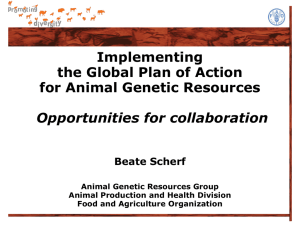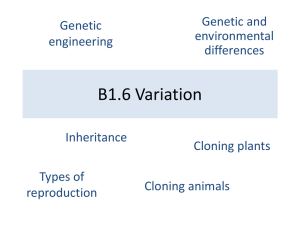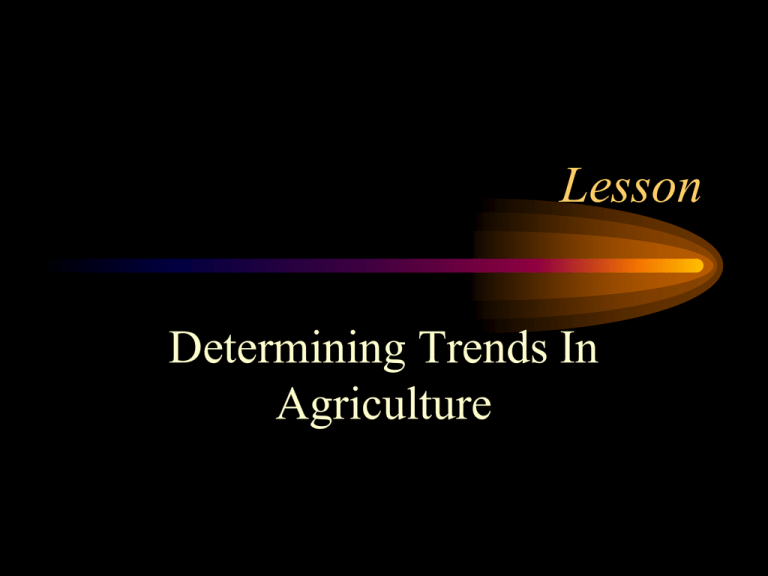
Lesson
Determining Trends In
Agriculture
Student Objectives
• Identify trends in animal agriculture
• Identify trends in plant agriculture
• Explain historical events leading to the
development of today’s ag industry
Objective One
Identify Trends In Animal
Agriculture
Animal Improvement and Breeding
• Prior to the 1960’s improvement was
limited to natural selection
• Natural Selection is a process where
animals with superior genetic quality
are used for breeding
• Animals with less desirable traits are
eliminated from the population
Animal Improvement and Breeding
• Widespread use of Artificial Insemination
began in the 1960’s
• Artificial Insemination involves uniting
the male sperm cells and the female ova
• AI greatly increases the use of genetically
superior males
Animal Improvement and Breeding
• The development of superovulation
and embryo transfer has greatly
increased the number of offspring a
genetically superior female can
produce in her lifetime
Improving Animal Production
• Biotechnological discoveries in recent
years have helped to improve animal
production and efficiency
• Using results from biological scientific
investigation and research and putting
it to practical use in agriculture is
called biotechnology
Improving Animal Production
• Bovine somatotropin, or bST, is a
hormone which will increase milk
production when given to cows
• The hormone was found to occur
naturally in cows and is found in all
milk
Improving Animal Production
• Porcine somatotropin, or pST, is a
hormone that regulates growth rates in
pigs and will increase the production of
muscle cells and feed efficiency if
given to hogs
Improving Animal Production
• Implants are small pellets that can be
placed under the skin of animals. The
pellets contain hormones or other
growth regulators which will release
slowly to improve the animals
production and efficiency
Genetic Improvement
• During the 1980’s, scientists
discovered the process of changing the
genetic information of DNA and were
able to move genes from one cell to
another. This process is often referred
to as genetic engineering
Genetic Improvement
• A transgenetic animal is one that has
had its genes altered or manipulated
• Genetic improvements can also
improve the productive ability and
efficiency of livestock
Other Animal Industry Trends
• Aquaculture is a rapidly growing
enterprise in the ag industry and has
provided a niche market for some
producers
• Aquaculture is the production of fish
and other aquatic plants and animals
Objective Two
Identify Trends In Plant
Agriculture
Improving Plant Production
• Since the 1920’s, ag scientists have
discovered that many fertilizers,
pesticides, machines, and other
technologies have improved plant
production and efficiency when put to
use
Improving Plant Production
• Tractors replaced the use of horses and
led to what has been termed the second
agricultural revolution
• Tractors outnumbered horses and
mules on farms for the first time in
1954
Improving Conservation
• Conventional tillage operations,
which used moldboard plowing, gave
way to conservation tillage practices
like minimum tillage (no moldboard
plow and fewer seedbed tillage
practices) and no-tillage, where only
planting, spraying, and harvesting is
done
Improving Conservation
• More and more producers began using
Low Input Sustainable Agriculture
(LISA) techniques.
• LISA involves using less chemicals
and commercial fertilizers while
maintaining production efficiency and
profit
Genetic Improvement
• Genetic engineering has created plants
which are resistant to specific
herbicides, insects, and diseases
• Genetically modified organisms
(GMO’s) like BT corn and Roundup
Ready Soybeans are widely used
Genetic Improvement
• Some plants have been developed
which are more resistant to frost
damage
• Other plants have been improved
genetically to give them a longer
storage or shelf life
Genetic Improvement
• Cloning techniques have been
improved. Cloning is an asexual
reproduction method where no union
of male and female sex cells occurs
• Methods of tissue culture, which is
propagating plants from a single cell or
group of cells, have been perfected
Information Super Highway
• The 1990’s brought the information
age to agriculture
• Global Positioning Systems (GPS) use
satellites to find exact field locations
for grid mapping, soil sampling, and
monitoring harvest yield results
Information Super Highway
• Site specific farming involves
applying different cultural practices to
meet the needs of different field
locations
• VRT (variable rate technology), for
example,involves applying different
fertilizer or pesticide rates to different
field locations based upon site needs
Information Super Highway
• The widespread use of computers and
computer technology has created many
improvements in production
• The internet is a computer network
linking communications for
agribusinessmen and producers across
the nation and around the world
Objective Three
Explain Historical Events
Leading to the Development
of Today’s Ag Industry
Historical Developments
• Historical events help us understand our
present and predict or future
• At the time of the Declaration of
Independence, nearly 90% of the people
were farming
• George Washington and Thomas Jefferson
were very progressive farmers
Historical Developments
• In the 1800’s, our nation’s ag policy
began to take shape as Congress
established ag programs and passed
new ag laws
• 1825--Congress established a special
committee for agriculture
Historical Developments
• 1852--The U.S. Patent Office began
agricultural research
• 1862--The USDA (United States
Department of Agriculture) was
established.
Historical Developments
• Can you think of other historical
events which have had a significant
impact on American agriculture as
we know it today?
(We have discussed many this week)

